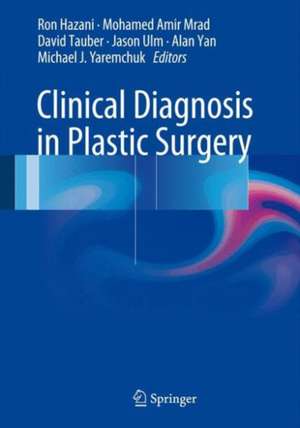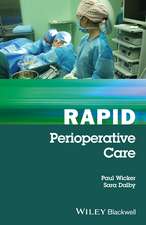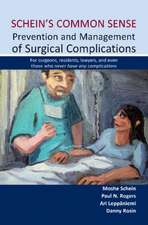Clinical Diagnosis in Plastic Surgery
Editat de Ron Hazani, Mohamed Amir Mrad, David Tauber, Jason Ulm, Alan Yan, Michael J. Yaremchuken Limba Engleză Hardback – 28 noi 2015
| Toate formatele și edițiile | Preț | Express |
|---|---|---|
| Paperback (1) | 364.17 lei 6-8 săpt. | |
| Springer International Publishing – 23 aug 2016 | 364.17 lei 6-8 săpt. | |
| Hardback (1) | 361.83 lei 38-44 zile | |
| Springer International Publishing – 28 noi 2015 | 361.83 lei 38-44 zile |
Preț: 361.83 lei
Preț vechi: 380.88 lei
-5% Nou
Puncte Express: 543
Preț estimativ în valută:
69.26€ • 75.25$ • 58.21£
69.26€ • 75.25$ • 58.21£
Carte tipărită la comandă
Livrare economică 17-23 aprilie
Preluare comenzi: 021 569.72.76
Specificații
ISBN-13: 9783319170930
ISBN-10: 3319170937
Pagini: 190
Ilustrații: X, 156 p.
Dimensiuni: 178 x 254 x 15 mm
Greutate: 0.68 kg
Ediția:1st ed. 2016
Editura: Springer International Publishing
Colecția Springer
Locul publicării:Cham, Switzerland
ISBN-10: 3319170937
Pagini: 190
Ilustrații: X, 156 p.
Dimensiuni: 178 x 254 x 15 mm
Greutate: 0.68 kg
Ediția:1st ed. 2016
Editura: Springer International Publishing
Colecția Springer
Locul publicării:Cham, Switzerland
Public țintă
Professional/practitionerCuprins
Craniofacial: The Ear.- The Orbit.- The Nose.- Orthognathic Conditions.- Oral and Facial Clefts.- Craniosynostosis.- Pediatric Syndromes.- Hemifacial Microsomia.- Craniomaxillofacial Trauma. Breast and Trunk: Breast.- Implant related findings.- Chest Wall.- Pressure Sores. Hand and Lower Extremities: Congenital.- Trauma.- Vascular.- Tumors.- Nerve.- Arthritis.- Infection.- Dupuytrens Disease. Integument: Burns.- Benign and malignant lesions.- Vascular Malformations.
Recenzii
“This is an atlas of common pathological conditions encountered in a plastic surgical clinical setting. … The clinical examples are useful to students, residents, and established plastic surgeons who wish a brief look at pathological conditions. … Those who wish a quick perusal of a few of the common clinical conditions encountered in plastic surgery will find this book of interest.” (Jeffrey S. Rosenthal, Doody’s Book Reviews, April, 2016)
Notă biografică
Ron Hazani, MD, FACS, is a plastic and craniofacial surgeon practicing in Beverly Hills, CA. He is an Associate Member at Cedars-Sinai Medical Center and at St. John’s Health Center. Dr. Hazani completed his clinical fellowship at Harvard Medical School in aesthetic and craniofacial surgery with the Division of Plastic and Reconstructive Surgery, Massachusetts General Hospital, Boston, MA. He had previously completed a fellowship in plastic, hand, and reconstructive microsurgery at the Buncke Clinic—University of California, San Francisco.
Dr. Hazani graduated Magna Cum Laude with Honors at UCLA. He received his Medical Degree from the Loma Linda University School of Medicine, CA. Following a surgical internship at the University of Texas at Houston, he completed his general surgery residency at the Albert Einstein College of Medicine—Long Island Jewish Medical Center. Dr. Hazani completed his Plastic Surgery training at the University of Louisville, where he also helda position as an Assistant Professor at the Division of Plastic Surgery. He has received a number of awards for his research and academic achievements and has authored 30 peer-reviewed publications and book chapters. Dr. Hazani is certified by the American Board of Surgery and is a Fellow of the American College of Surgeons.
Mohamed Amir Mrad gained his MBBS from King Saud University, Riyadh, KSA, in 2003 and in addition holds an MRCS (Great Britain & Ireland) and an Executive MBA (Rotman School of Management, University of Toronto, Canada). Dr. Mrad is a Fellow of the Royal College of Physicians and Surgeons of Canada (FRCSC) and the American College of Surgeons (FACS). Subsequent to plastic surgery residencies in Riyadh and the University of Toronto, he undertook a Craniofacial Fellowship at Sunnybrook Hospital, Toronto and a Craniofacial and Aesthetic Fellowship at Harvard Medical School, MGH, Boston, MA, and The Boston Centre for Cosmetic Surgery. Dr. Mrad is
currently aConsultant Craniofacial and Plastic Surgeon at King Faisal Specialist Hospital and Research Centre, Riyadh, Saudi Arabia. He is an active member of the American Society of Plastic Surgeons (ASPS) and the Canadian Society of Plastic Surgeons (CSPS). Dr. Yaremchuk is Clinical Editor of Aesthetic Surgery Journal and is on the editorial board of the Annals of Plastic Surgery. He is a longstanding member of various professional societies and has been a member of the Plastic Surgery Research Council since 1986. Dr. Yaremchuk has repeatedly been listed in Best Doctors in America. He is the author of more than 100 original articles as well as many book chapters, reviews and editorials.
Dr. Hazani graduated Magna Cum Laude with Honors at UCLA. He received his Medical Degree from the Loma Linda University School of Medicine, CA. Following a surgical internship at the University of Texas at Houston, he completed his general surgery residency at the Albert Einstein College of Medicine—Long Island Jewish Medical Center. Dr. Hazani completed his Plastic Surgery training at the University of Louisville, where he also helda position as an Assistant Professor at the Division of Plastic Surgery. He has received a number of awards for his research and academic achievements and has authored 30 peer-reviewed publications and book chapters. Dr. Hazani is certified by the American Board of Surgery and is a Fellow of the American College of Surgeons.
Mohamed Amir Mrad gained his MBBS from King Saud University, Riyadh, KSA, in 2003 and in addition holds an MRCS (Great Britain & Ireland) and an Executive MBA (Rotman School of Management, University of Toronto, Canada). Dr. Mrad is a Fellow of the Royal College of Physicians and Surgeons of Canada (FRCSC) and the American College of Surgeons (FACS). Subsequent to plastic surgery residencies in Riyadh and the University of Toronto, he undertook a Craniofacial Fellowship at Sunnybrook Hospital, Toronto and a Craniofacial and Aesthetic Fellowship at Harvard Medical School, MGH, Boston, MA, and The Boston Centre for Cosmetic Surgery. Dr. Mrad is
currently aConsultant Craniofacial and Plastic Surgeon at King Faisal Specialist Hospital and Research Centre, Riyadh, Saudi Arabia. He is an active member of the American Society of Plastic Surgeons (ASPS) and the Canadian Society of Plastic Surgeons (CSPS). Dr. Yaremchuk is Clinical Editor of Aesthetic Surgery Journal and is on the editorial board of the Annals of Plastic Surgery. He is a longstanding member of various professional societies and has been a member of the Plastic Surgery Research Council since 1986. Dr. Yaremchuk has repeatedly been listed in Best Doctors in America. He is the author of more than 100 original articles as well as many book chapters, reviews and editorials.
Textul de pe ultima copertă
This book systematically presents a collection of entities, syndromes, and diseases that are diagnosed and treated by plastic surgeons, hand surgeons, otolaryngologists, oral surgeons, and dermatologists. The goal is to document an extensive array of signs and visual clues that are critical to the diagnostic process, thereby enhancing the clinician’s ability to identify relevant diagnostic features and make correct diagnoses. Skill in recognizing deformities and disease processes by observation is of vital importance in plastic surgery, which is very much a visual surgical specialty. In drawing together key diagnostic signs, this book will spare readers the onerous task of searching through endless resources, books, and websites. A helpful appendix details the various classification systems used in the book with the aid of appropriate diagrams. Clinical Diagnosis in Plastic Surgery is intended for students, residents, practicing physicians, and surgeons in all of the affiliated fields of plastic surgery.
Caracteristici
Clear format designed to facilitate fast and reliable diagnosis of clinical entities seen by plastic surgeons in practice Wealth of photographs and X-rays Appendix detailing the classification systems used in the book with appropriate diagrams







